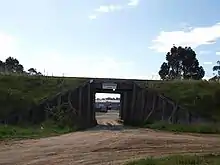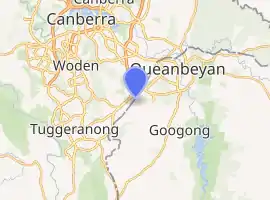Petrov's Bridge
Arnott Street Railway Bridge (Petrov's Bridge) was a small, isolated railway bridge in Canberra, most famously used by soviet agent Vladimir Petrov in 1954 as a Dead drop location for Australian Security Intelligence Organisation (ASIO). The bridge was used as part of the Bombala railway line before it was destroyed in 2018.
Petrov's Bridge | |
|---|---|
 A picture of Petrov's Bridge prior to its destruction | |
| Coordinates | 35.388719°S 149.174607°E |
| Carries | Trains |
| Locale | Hume |
| Official name | Arnott Street Railway Bridge |
| Other name(s) | Petrov's Bridge |
| Named for | Vladimir Petrov |
| Characteristics | |
| Material | Wood |
| Total length | Approx 2m |
| Height | 3.8m |
| Clearance below | 3.7m |
| History | |
| Opened | 1887[1] |
| Destroyed | 2018[2] |
| Closed | 1989 |
| Location | |

| |
Petrov's Bridge also less commonly refers to the bridge Petrov revealed as a Soviet dead drop site, a different bridge along the Bombala railway line a few miles outside the Canberra railway station.[3]
History
Petrov's Bridge was built in 1887 as part of the Bombala railway line extension from Bungendore to Michelago. It was built to cross one of the few rural roads that existed in the area around Queanbeyan at the time.[4] Its original wood and stone construction persisted its entire 131 years of existence.[5]
Allegedly, during the 1950s a dark coloured car with tinted windows could regularly be seen near the bridge, as well as Petrov's Skoda on occasion.[6]
During the 1970s Arnott Street was the main access road to the Tralee Speedway for the ACT.
In 1982 Hume was gazetted and the bridge became part of the new suburb.
By 1989 both freight and passenger service had ceased south of Queanbeyan, leaving the bridge unused.[7][8]
In 2018 the bridge was demolished, with Transport NSW citing safety concerns over the low height of the bridge.[6]
As a dead drop location
During the 1950s Vladimir Petrov operated as the leader of the Soviet espionage efforts within their embassy in Canberra. In 1954, after the instability caused by the death of Joseph Stalin, Petrov made contact with ASIO and offered to provide evidence of the espionage efforts in exchange for political asylum. Over the next few months, ASIO and Petrov exchanged information and his escape plan through dead drops.[9] The Arnott Street Railbridge was chosen as the dead drop location because of its isolation and abundance of hiding places.
Although the location of the bridge Petrov made his drops at was never officially disclosed, Petrov described the bridge in his testimony to the Royal Commission on Espionage as a railbridge located on the Queanbeyan rail line about "six and a half miles from Canberra".[10] The only bridge fitting that description at the time was the Arnott Street Railway Bridge.[6]
See also
References
- Stokes, HJW (1984). Railways of the Canberra and Monaro Districts. Canberra: Australian Railway Historical Society, ACT Division. pp. 4, 5.
- Man, Tim the Yowie (2018-05-22). "A bridge too far? Location of secret Soviet spy business demolished". The Sydney Morning Herald. Retrieved 2019-07-19.
- "PETROV BRIDGE". Maryborough Chronicle (Qld. : 1947 - 1954). 1954-05-18. p. 4. Retrieved 2019-07-20.
- "Parish of Jeir, County of Murray [cartographic material] : Land Districts of Yass & Queanbeyan". nla.gov.au. Retrieved 2019-07-20.
- "File:Petrov's Bridge.jpg", Wikipedia, retrieved 2019-07-20
- Man, Tim the Yowie (2018-05-22). "A bridge too far? Location of secret Soviet spy business demolished". The Canberra Times. Retrieved 2019-07-19.
- "Last Cooma Freight" Railway Digest July 1989 page 237
- "Cooma" Railway Digest February 1989 page 55
- corporateName=National Museum of Australia; address=Lawson Crescent, Acton Peninsula. "National Museum of Australia - Petrov Affair". www.nma.gov.au. Retrieved 2019-07-20.CS1 maint: multiple names: authors list (link)
- "Royal Commission on Espionage" (PDF). University of Adelaide. 1955. Retrieved 2019-07-21.